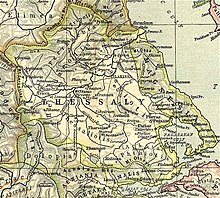Ancient Thessaly
|
Thessalia Θεσσαλία |
|
|---|---|
| Region of Ancient Greece | |

Ancient theatre in Larissa
|
|

Map of ancient Thessaly
|
|
| Location | Thessaly |
| Major cities | Larissa, Pherae |
| Dialects | Aeolic |
| Key periods | Pheraean Ascendancy |
Thessaly or Thessalia (Attic Greek: Θεσσαλία, Aeolic Greek (Thessalian): Πετθαλία, Petthalia) was one of the traditional regions of Ancient Greece. During the Mycenaean period, Thessaly was known as Aeolia, a name that continued to be used for one of the major tribes of Greece, the Aeolians, and their dialect of Greek, Aeolic.
At its greatest extent, ancient Thessaly was a wide area stretching from Mount Olympos to the north to the Spercheios Valley to the south. Thessaly is a geographically diverse region consisting of broad central plains surrounded by mountains. The plains are bounded by the Pindos Mountains to the west, Mount Othrys to the south, the Pelion and Ossa ranges to the east, and Mount Olympos to the North. The central plains consist of two basins, the Larisa basin and the Karditsa basin, drained by the Pineios River into the Vale of Tempe. The Pagasetic Gulf in southeastern Thessaly was and is the only body of water suitable for harbours in region.
Strictly speaking, Thessaly refers primarily to the central plains inhabited by the Thessalians in antiquity. The plains were divided in antiquity into four administrative regions called tetrads: Pelasgiotis, Phthiotis, Thessaliotis, and Histiaeotis. In its broader sense, Thessaly also included the surrounding regions called the perioikoi, which were regions inhabited by different ethnic groups that were closely tied to the Thessalians either as subordinates, dependents, or allies. The perioikoi were composed of Perrhaibia, Magnesia, Achaea Phthiotis, Dolopia, Ainis, Malis, and Oitaia. The three largest cities in Thessaly were Larisa (Pelasgiotis), Pherai (Pelasgiotis), and Pharsalos (Phthiotis).
...
Wikipedia
